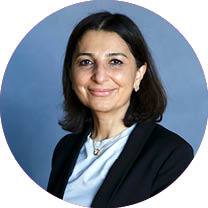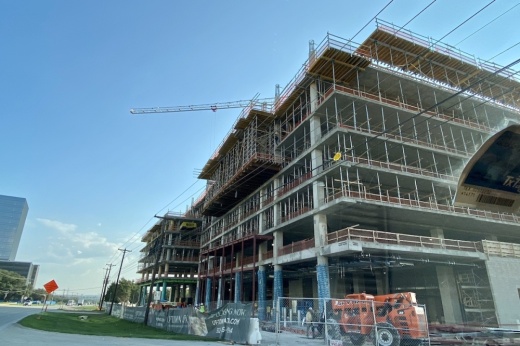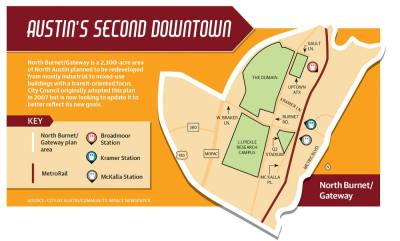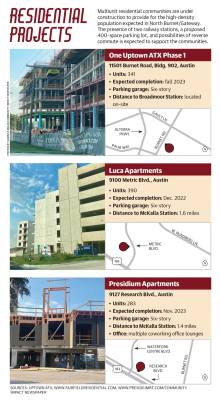The plan has gone through many updates, but the city is planning to further modify it to include a transit hub with train and bus lines for commuters to access downtown and other parts of Greater Austin. The updated plan includes increasing density in mixed-use buildings and amending rules and codes to accelerate development.
“The community sees [North Burnet/Gateway] as a regional center that is pulling people in from all parts of not just the city, but the counties that are adjacent to Austin. [This] allows some people to live further north where maybe the housing is less expensive and then commuting to Austin’s second downtown,” District 7 Council Member Leslie Pool said.
Pool’s district houses the North Burnet/Gateway area. She has been a part of the plan’s updates since 2015 and is responsible for a number of amendments in the original plan. Development never really stopped during the COVID-19 pandemic and accelerated extraordinarily north of US 183, Pool said.
“We wanted to have some coherence to that development and a regulating plan. All of these things work together to help give predictability to developers and investors, and it also gives us a sense of place for residents in the vicinity and people who work there,” Pool said.
North Burnet/Gateway has a separate zoning code within its boundaries and a subdistrict map, which outlines different levels of entitlements or legal agreements with the city for land use than surrounding areas. City planners and urban designers officially laid it out in 2006 to focus on Austin’s growth and make it a transit-oriented district. Developers have come to them saying the plan needs an update, Pool’s staff said.
Creating, updating the plan
Austin City Council began analyzing a 2,300-acre area in North Austin in 2006 as a regional center for urbanization because it had a mix of commercial and industrial areas and few residences. A 2000 census showed 4,800 residents living in the North Burnet/Gateway area.
The plan shows a long-range redevelopment concept spanning 30 years with 40,000 residential dwelling units, 12 million-13 million square feet of office and commercial space, and 4 million-5 million square feet of retail, according to previous Community Impact Newspaper reporting. The plan also envisioned hotels, industrial warehouse and service space, and a maximum building height of 30 stories.
Austin City Council adopted the plan in 2007 and has approved many updates since to facilitate development. Some of these updates allowed room for affordable housing units in the mixed-use spaces, defined as rent and utilities costing no more than 30% of a household’s gross income, said Jeffery Patterson, public information specialist for the city of Austin’s Housing and Planning Department.
Fast forward to 2022, and development in The Domain, inauguration of the Q2 Stadium and Austin FC, and the construction of several apartment communities has added more people to North Burnet/Gateway. Additionally, the presence of Apple, Samsung and Amazon campuses in the north has caused reverse commute, with large amounts of workers traveling from the city to suburban areas for work.
Capital Metro, which operates MetroRail, a commuter train that connects Leander to downtown, has started building two railway stations within 1 mile of each other in the North Burnet/Gateway zone. This makes the North Burnet/Gateway area the center of transit for commuters and an economic focus away from downtown.
“We really can’t just stuff it all into 19 square blocks downtown; it really had to have a release valve,” Pool said.
Two Austin City Council resolutions initiated by Pool this year gave a major thrust forward to changes in the plan. A May resolution amended the maximum height of buildings in North Burnet/Gateway depending on use to 420 feet tall, or about 38-40 stories, instead of the original 308 feet tall, or about 28-30 stories. It also increased the floor-to-area ratio, or the size of the building’s floor related to the site, to allow greater density and increase the square footage in a building.
Community partners
The city will connect with major stakeholders for input on the plan to form their recommendations to the city, said Jorge Rousselin, division manager of zoning urban design for the city of Austin who manages the transit-oriented development programs.
These include Capital Metro; the Austin Transit Partnership; Austin FC; Q2 Stadium; the Austin Economic Development Partnership; and the J.J. Pickle Research Campus at The University of Texas at Austin, which neighbors the North Burnet/Gateway area. They also include current property and business owners as well as those who frequent the area or live nearby.
In anticipation for the development happening in the North Burnet/Gateway area, the McKalla and Broadmoor stations are under construction, said Lonny Stern, interim director of community engagement at the Austin Transit Partnership. The McKalla Station will serve the Q2 Stadium, and the Broadmoor Station will be across the street from the north side of The Domain.
Capital Metro broke ground on the Broadmoor MetroRail Station on Jan. 18. It is about a half-mile north of the existing Kramer Station, which will be decommissioned once Broadmoor is up and running in early 2024.
“There will be new parking facilities that are serving the station up by Broadmoor station in particular, which is a real improvement because our current station in that area doesn’t have any parking, and commuters have to go a little further north to Howard to find a spot,” Stern said.
The McKalla Station will open in late 2023 and will have two passenger platforms as well as a special events platform. It will provide connectivity for the North Burnet area and increase transit access to high-activity destinations, according to Capital Metro.
Building out the plan
Several new developments are under construction in the North Burnet/Gateway area, including Brandywine Realty Trust’s Uptown ATX campus, a 66-acre master-planned mixed-use development on Burnet Road at Palm Way. This site, formerly called the IBM Broadmoor campus, will have additional office space as well as retail and residential space, 50% affordable housing, parks and amenities.
When complete, Uptown ATX will be the largest transit-oriented master-planned community in Austin, and Broadmoor will be the second largest Capital Metro Station by ridership on the Red Line, Brandywine spokesperson Laura Miller said.
Brandywine and Capital Metro have a partnership to develop the Broadmoor Station, which passes through Uptown ATX. Phase 1, called One Uptown ATX, is under construction with 341 units of office space on 5 acres. The office space is expected to be complete in fall 2023 followed by the residential spaces in fall 2024.
“The North Burnet/Gateway area is growing explosively, partly catalyzed by the redevelopment of The Domain, and we at Capital Metro and the Austin Transit Partnership recognize that growth and are trying to improve services in that area to meet the moment,” Stern said.
To add to the region’s growth, other apartment communities in the plan area, such as the 390-unit Luca apartments at 9100 Metric Blvd., Austin, and the 283-unit Presidium apartments at 9127 Research Blvd., Austin, are expected to complete construction by early 2023. The housing developments also have to offer a certain amount of affordable housing as required in the North Burnet/Gateway plan.
Although not part of the North Burnet/Gateway plan, The Domain, which has its own planned development agreement, remains an influencer. Parts of The Domain that were designed in Phase 2, such as those surrounding Dick’s Sporting Goods, are being redesigned to bring them up to par with current developments in the North Austin area, according to Pool’s staff.
To further improve the plan, City Council asked the city manager’s office for recommendations, such as expanding transit-oriented development, increasing the height of buildings, adding more transit options and adjusting land-use standards.
Pool’s office is expecting these recommendations to come out in late fall. Following this, council members would decide which recommendations to amend into the plan. Pool said she is excited about the Braker and Burnet intersection becoming a transit hub.
“Hopefully it will have some impact on affordability for people, if they don’t have to buy a car or be in their car as much as they’re able to use public transportation; that is always less expensive,” Pool said.










